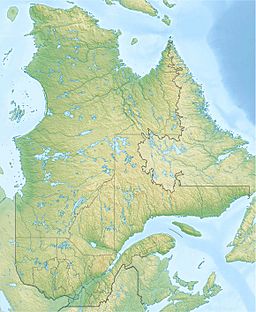Petit lac Manicouagan facts for kids
Quick facts for kids Petit lac Manicouagan |
|
|---|---|
| Coordinates | 51°53′34″N 67°43′32″W / 51.89278°N 67.72556°W |
| Catchment area | 4,553 square kilometres (1,758 sq mi) |
| Designation | Lake/reservoir |
| Surface area | 25,160 hectares (62,200 acres) |
| Water volume | 1,430,000,000 cubic metres (5.0×1010 cu ft) |
The Petit lac Manicouagan is a lake in the Côte-Nord region of Quebec, Canada. Its name means "Little Manicouagan Lake." A dam called the Hart-Jaune Dam holds back its water. This dam is at the start of the Hart Jaune River.
Contents
Where is Petit lac Manicouagan?
Petit lac Manicouagan is in an area called Rivière-Mouchalagane. This area is in Caniapiscau, Quebec. It lies east of Quebec Route 389. The Cartier Railway follows the lake's southeast side. The railway goes into the lake's southern end. It passes through a narrow gorge. This gorge leads to the start of the Northeast Toulnustouc River.
The lake is split between several land divisions. These are called cantons. They include Hesry (northwest), Fagundez (southwest), Le Courtois (southeast), and Leventoux (northeast). The very northern tip is in the canton of Tilly. The southern arm reaches into the canton of Forgues.
Petit lac Manicouagan is part of the Beaupré River system. This river flows into the Manicouagan Reservoir. The lake holds about 1.43 billion cubic meters of water. It covers an area of 251.60 square kilometers. The land that drains into the lake is 4,553 square kilometers wide.
What Does "Manicouagan" Mean?
The word Manicouagan comes from the Innu language. It might mean "where bark is taken." Another idea is that it means "drinking vessel." A similar Innu term, Mrnikuanistuku Shipu, means "river by the cup."
Père Lemoine, a historical figure, gave two meanings. One is "place where we remove birch bark." The other is "Where we give a drink." These meanings might be linked. Birch bark was used to make bowls for drinking water. The Commission de toponymie du Québec thinks Petit lac Manicouagan was named for its spoon shape.
Animals and Nature Around the Lake
The Uapishka Biodiversity Reserve protects the land south of the lake. This area includes the Monts Groulx mountains and the Hart Jaune River.
- Caribou in the Area
A group of Caribou used to live around the lake. In 1972, this group was near the southern edge of where caribou lived. In the past, caribou roamed much further south. People hunted the Petit lac Manicouagan caribou in the fall during the 1970s and 1980s. They hunted them in the winter in the 1990s. The number of caribou caught in the fall went down. The winter hunt caught many more caribou. Some caribou groups have greatly decreased in number. By 2017, it was not known if the Petit lac Manicouagan herd still existed.
- Protected Areas
Parts of the lake's southwest shore are in the Bersimis (Pessamit) Reserve. This is a special area for beavers. The Betsiamites (Pessamit) heritage site covers 652 square kilometers. This site includes land around the Hart Jaune River and Petit lac Manicouagan.
The Hart-Jaune Dam
The Hart-Jaune dam and power plant were started in 1957. The Québec Cartier Mining Company built them. This company was created by U.S. Steel to get iron ore. In February 1957, the government allowed the company to use the water power of the Hart-Jaune River and Petit lac Manicouagan. This included the right to control the river's flow and store water in the lake. The dam was finished in 1960.
In 1998, Hydro Quebec got permission for a project. They filled in a 2,385-meter section of the lake and river. This was to fix the rock protection of the dam structures. The dam has made it harder for fish to move freely.
Predicting Water Flow
The Petit Lac Manicouagan area is one of five main water collection areas. These areas are part of the larger Manicouagan watershed. The others are Manic-5, Toulnoustouc, Manic-3, and Manic-2.
Scientists use daily weather forecasts for each area. This helps them predict how much water will flow in the rivers. Studies have shown that combining data from different sources makes predictions better. Then, using statistics helps even more. This improved forecasting helps manage the dam operations better.


